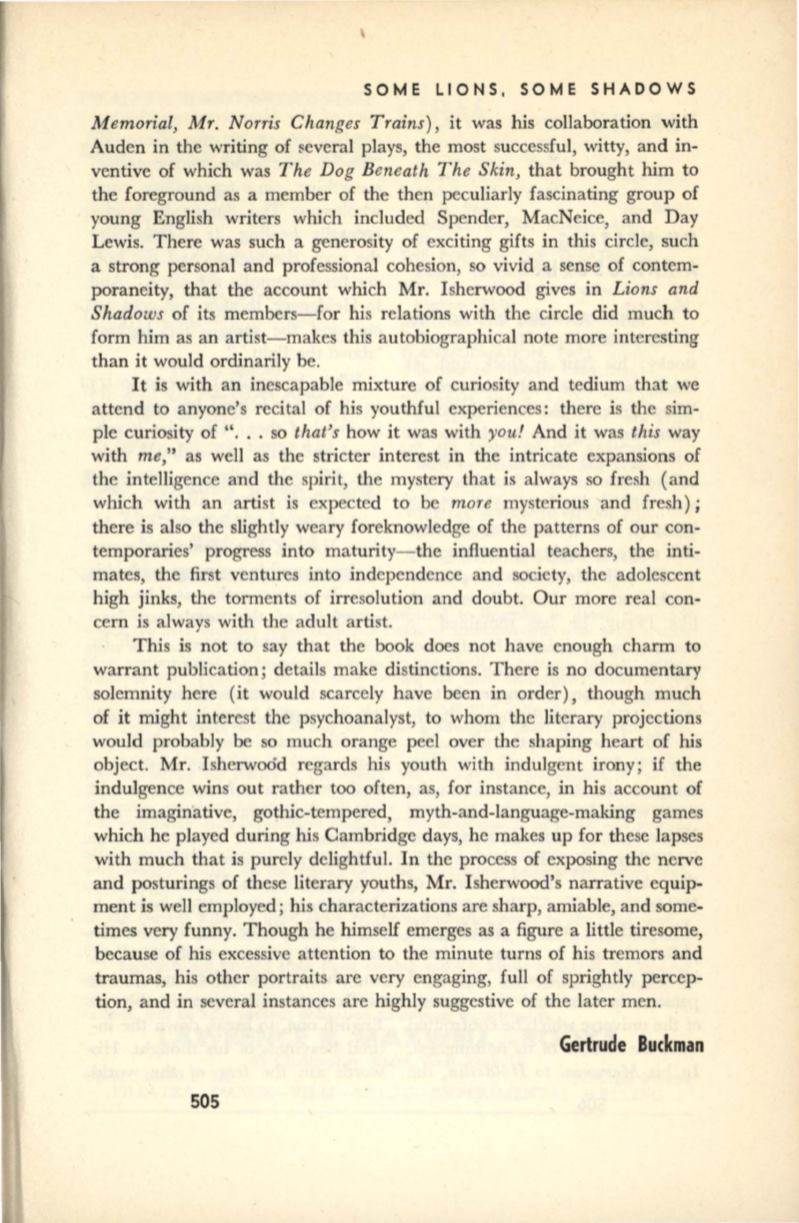
SOME LIONS, SOME SHADOWS
Memorial, Mr. Norris Changes Trains),
it was his collaboration with
Auden in the writing of several plays, the most successful, witty, and in–
ventive of which was
The Dog Beneath The Skin,
that brought him to
the foreground as a member of the then peculiarly fascinating group of
young English writers which included Spender, MacNeice, and Day
Lewis. There was such a generosity of exciting gifts in this circle, such
a strong personal and professional cohesion, so vivid a sense of contem–
poraneity, that the account which Mr. Isherwood gives in
Lions and
Shadows
of its members-for his relations with the circle did much to
form him as an artist-makes this autobiographical note more interesting
than it would ordinarily be.
It is with an inescapable mixture of curiosity and tedium that we
attend to anyone's recital of his youthful experiences: there is the sim–
ple curiosity of " ... so
that's
how it was with
you!
And it was
this
way
with
me,"
as well as the stricter interest in the intricate expansions of
the intelligence and the spirit, the mystery that is always so fresh (and
which with an artist is expected to be
more
mysterious and fresh) ;
there is also the slightly weary foreknowledge of the patterns of our con–
temporaries' progress into maturity-the influential teachers, the inti–
mates, the first ventures into independence and society, the adolescent
high jinks, the torments of irresolution and doubt. Our more real con–
cern is always with the adult artist.
This is not to say that the book does not have enough charm to
warrant publication; details make distinctions. There is no documentary
solemnity here (it would scarcely have been in order), though much
of it might interest the psychoanalyst, to whom the literary projections
would probably be so much orange peel over the shaping heart of his
object. Mr. Isherwood regards his youth with indulgent irony;
if
the
indulgence wins out rather too often, as, for instance,
in
his account of
the imaginative, gothic-tempered, myth-and-language-making games
which he played during his Cambridge days, he makes up for these lapses
with much that is purely delightful. In the process of exposing the nerve
and posturings of these literary youths, Mr. Isherwood's narrative equip–
ment is well employed; his characterizations are sharp, amiable, and some–
times very funny. Though he himself emerges as a figure a little tiresome,
because of his excessive attention to the minute turns of his tremors and
traumas, his other portraits are very engaging, full of sprightly percep–
tion, and in several instances are highly suggestive of the later men.
Gertrude Buckman
505


